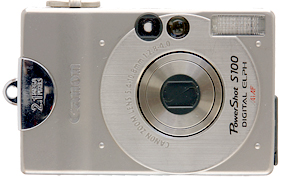
Approx. dates of manufacture: 2000
Approx. original price: $599!
Sensor Size: CCD 1/2.7"
Max Resolution: 1600x1200
Memory card: Compact Flash (CF)
Approx. street value: Low
In the 90s, a variety of camera makers tried once again to replace 35mm film (prior attempts at killing 35mm included the unlamented 828 and 126 cassette). This time they used computer technology to encode information that would help photofinishers make better images. They called it Advanced Photo System, or APS for short.
Canon's APS cameras were called Elphs in the USA; they were very small and compact and popular. But APS came too late in life to become a major player. Digital still-cameras finally took off in the late 90s, and the people who APS appealed to bought digital cameras instead.
Canon decided to cash in on its name, and decided to use it on a series of digital cameras. Canon's standard digital-camera name was Powershot, but they had no problem concatenating everything together. So my camera is officially a Powershot S100 Digital Elph. Most people I know called it an Elph and reserve the Powershot name for the other models (like the A series and the G series) that Canon makes. (The photograph of it here says Ixy, which is the Japanese designation.)
Neat camera. About the size of a pack of smokes so it easily fits in a shirt pocket. Its case has a lot of plastic but it looks like brushed stainless steel, and between that and its weight (considerable for such a small camera), this camera feels a quality machine. Other nice things: the lens completely retracts behind a metal door so there's no lens cap to lose, and the controls are easy and well thought out.
The bad parts are the things that plague Canons of all kinds: the fragility of the battery and memory card doors. Almost everyone I know who has a Canon digital has snapped the battery door off it—simply from normal use rather than carelessness (and the film camera doors often break as well. See my AL-1). If you look at it you'll see why: there's a thin plastic piece that makes up the hinge, and it's easy to break. Since the camera has a rechargable battery and gets opened and closed often, Canon really should have beefed up this part.
Ironically, the battery door on my camera is fine; but the memory card door is completely gone. I got the camera for $27 from a thrift shop because that door is gone (and it's missing its oddball rechargable battery). The thrift shop couldn't/didn't test it so I got it cheap because I gambled that the camera would work. The owner's manual was a free download from Powershot.com Canon's website to support its digital cameras. I ordered a door from Huron Camera and a battery and charger off eBay and now I've got a perfectly good camera.
*** A few months ago I gave that camera to a friend's kid. He wanted a "good" digital camera but one that would survive a boy's life, and one that wasn't so expensive that it would be a tragedy if something happened to it.
Later on I decided I wanted a "grab shot" camera, something I could carry around with me easily in a pocket, like when I'm out walking the dog. My DSLR is great but it's not discrete nor easily carried nor quickly deployed. So I looked around for cheap digis and lo-and-behold, there was this one and another camera (my Toshiba PDR-M25) at a thrift shop, both for $4!
Want to know why? The memory card door was broken.
At least on this one, the door was still able to hang on if you were careful, so I put a battery and a CF card in it and it worked fine. It's quite a little camera.
Camera manual: Orphan Cameras.com



